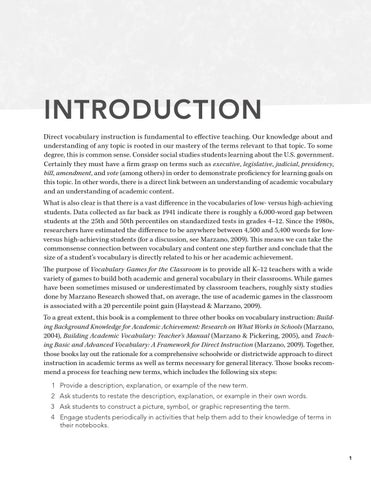INTRODUCTION Direct vocabulary instruction is fundamental to effective teaching. Our knowledge about and understanding of any topic is rooted in our mastery of the terms relevant to that topic. To some degree, this is common sense. Consider social studies students learning about the U.S. government. Certainly they must have a firm grasp on terms such as executive, legislative, judicial, presidency, bill, amendment, and vote (among others) in order to demonstrate proficiency for learning goals on this topic. In other words, there is a direct link between an understanding of academic vocabulary and an understanding of academic content. What is also clear is that there is a vast difference in the vocabularies of low- versus high-achieving students. Data collected as far back as 1941 indicate there is roughly a 6,000-word gap between students at the 25th and 50th percentiles on standardized tests in grades 4–12. Since the 1980s, researchers have estimated the difference to be anywhere between 4,500 and 5,400 words for lowversus high-achieving students (for a discussion, see Marzano, 2009). This means we can take the commonsense connection between vocabulary and content one step further and conclude that the size of a student’s vocabulary is directly related to his or her academic achievement. The purpose of Vocabulary Games for the Classroom is to provide all K–12 teachers with a wide variety of games to build both academic and general vocabulary in their classrooms. While games have been sometimes misused or underestimated by classroom teachers, roughly sixty studies done by Marzano Research showed that, on average, the use of academic games in the classroom is associated with a 20 percentile point gain (Haystead & Marzano, 2009). To a great extent, this book is a complement to three other books on vocabulary instruction: Building Background Knowledge for Academic Achievement: Research on What Works in Schools (Marzano, 2004), Building Academic Vocabulary: Teacher’s Manual (Marzano & Pickering, 2005), and Teaching Basic and Advanced Vocabulary: A Framework for Direct Instruction (Marzano, 2009). Together, those books lay out the rationale for a comprehensive schoolwide or districtwide approach to direct instruction in academic terms as well as terms necessary for general literacy. Those books recommend a process for teaching new terms, which includes the following six steps: 1 Provide a description, explanation, or example of the new term. 2 Ask students to restate the description, explanation, or example in their own words. 3 Ask students to construct a picture, symbol, or graphic representing the term. 4 Engage students periodically in activities that help them add to their knowledge of terms in their notebooks.
1
